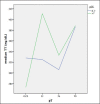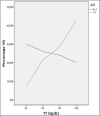Preoperative Plasma Levels of Total Testosterone Associated with High Grade Pathology-Detected Prostate Cancer: Preliminary Results of a Prospective Study in a Contemporary Cohort of Patients
- PMID: 28785191
- PMCID: PMC5527190
- DOI: 10.1159/000447155
Preoperative Plasma Levels of Total Testosterone Associated with High Grade Pathology-Detected Prostate Cancer: Preliminary Results of a Prospective Study in a Contemporary Cohort of Patients
Abstract
Objectives: To investigate the associations, if any, between preoperative plasma levels of total testosterone (TT) and pathology Gleason score (pGS) in a contemporary cohort of prostate cancer (PCa) patients.
Materials and methods: Between November 2014 and June 2015, plasma levels of TT were measured in 142 patients who underwent radical prostatectomy. Exclusion criteria were as follows: 5α-reductase inhibitors, LH-releasing hormone analogues, or testosterone replacement treatment. The entire cohort, assessed by continuous and categorical variables, was classified into two groups according to the pGS that included low-intermediate (pGS 6-7) and high grade (pGS > 7) cases. TT was evaluated as a continuous variable.
Results: The cohort included 128 cases. High grade PCa was detected in 28 (21.8%) patients. Median plasma levels of both TT and prostate specific antigen (PSA) were significantly higher in these cases. In the clinical multivariate model, independent and positive predictors of pGS > 7 were TT (p = 0.041; OR = 1.004), PSA (p = 0.006; OR = 1.191), and bGS > 6 (p = 0.004; OR = 5.0); that is, a single unit increase in TT plasma levels increases the odds of having high grade PCa by 4%.
Conclusion: In a contemporary cohort of patients, preoperative plasma levels of TT directly and independently associated with high grade PCa. High baseline plasma levels of TT might have clinical applications for managing PCa. New and well designed prospective studies dealing with this subject are required.
Keywords: Hyptothalamus-pituitary-testis-prostate axis; Prostate cancer; Retropubic radical prostatectomy; Robot assisted radical prostatectomy; Testosterone.
Figures




References
-
- Huggins C, Hodges CV. Studies on prostate cancer. I: The effect of castration, of estrogen and of androgen injection on serum phosphatases in metastatic carcinoma of the prostate. Cancer Res. 1941;1:293–297. - PubMed
-
- Stamey TA, Yang N, Hay AR, McNeal JE, Freiha FS, Redwine E. Prostate-specific antigen as a serum marker for adenocarcinoma of the prostate. N Engl J Med. 1987;317:909–916. - PubMed
-
- Armbruster DA. Prostate-specific antigen: biochemistry, analytical methods, and clinical application. Clin Chem. 1993;39:181–195. - PubMed
-
- Miller LR, Partin AW, Chan DW, Bruzek DJ, Dobs AS, Epstein JI, Walsh PC. Influence of radical prostatectomy on serum hormone levels. J Urol. 1998;160:449–453. - PubMed
-
- Olsson M, Ekstrom L, Schulze J, Kjellman A, Akre O, Rane A. Gustafsson: Radical prostatectomy: influence on serum and urinary androgen levels. Prostate. 2010;70:200–205. - PubMed
LinkOut - more resources
Full Text Sources
Other Literature Sources
Research Materials
Miscellaneous
